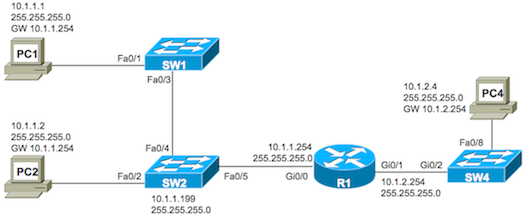CCENT Practice Question 101: Combining Protocols
One of the tougher things to do for #CCENT is to get used to all the new acronyms and figure out how they all fit together. Today I’ll start with a somewhat basic ICND1-level #CCENT question that gives you a chance to review some of the more common protocols and related acronyms. Then I’ll build a few more questions with this same topology and scenario, and ratchet up the challenge level a bit. For now, call this one a level 1 out of 5 for each concept, but it pulls a lot of concepts together, so call it a 2 out of 5.
As an aside, wow, wow, I didn’t realize it had been so long since I posted over here in the CCENT blog. For those of you who don’t know, I put posts related to the ICND1 side of CCNA here, and the ICND2 side over at the CCNA skills blog. I guess I’ve been spending more time in CCNA – and I’ve been admittedly burning too many candle ends to count of late. So let’s try a few sample practice questions to get back into things over here.
Scenario Details
This question uses the internetwork shown in Figure 1. The switches are all configured as layer 2 switches, with all ports as access ports in VLAN 2. The various devices use the IPv4 addresses shown in the figure.

Figure 1: Internetwork Used with this Question
Question
The user of PC1 opens a command prompt and issues the ping 10.1.2.254 command. The messages show that the ping works, with PC receiving responses. The command continues until the user presses a break sequence, like Ctl-C, to stop the command. Now think about what happens from the point the user issued the ping 10.1.2.254 command, until the user stopped the command. Which of the answers list a protocol that must have sent messages somewhere in this network during the time the ping command was working?
A) DHCP
B) CDP
C) ARP
D) ICMP
E) NDP
F) Some IP routing protocol
G) DNS
Answers in the next post. If you do want to comment or guess before the next post, please don’t put your answer in the subject line, to avoid spoiling it for the next person. Enjoy!

ICMP
[…] Check here for the original question before looking at the answer. […]
ICMP
Carlos,
That’s correct! Check the link at the bottom of this page, to the next post in sequence, which lists the additional explanation. Thanks for playing…
Wendell
Just found this blog today! Love it!
Just out of curiosity how far off exam level are these questions?
Hi Bav,
Welcome to the blog!
Actually, in the blog, I don’t worry about making the questions too hard. The goal here is to learn. For the questions with the books, we try and stick with exam-realism, and maybe a little on the tougher side of that. For instance, in this series, some of these were pretty long as far as time required to sift through the details.
Content-wise, they’re centered on the respective exams – ccentskills.com for ICND1/CCENT and ccnaskills.com for ICND2/CCNA.
Wendell
Hi, I just ran across the blog myself. Really nice book(100-102), I’m on the second read of Ch. 4. If you don’t mind, on the DIKTA quiz, page 90, question 3 does the Chapter explain why option e. is not an answer? A nice fellow explained it to me, but I was having a hard time finding it in the chapter itself. Thanks
Hi Brian,
Sorry, just saw your comment.
Anyway, in the ICND1 book, Chapter 4, DIKTA question 3, answer E is incorrect due to the following:
“223.223.223.255 is the network broadcast address for Class C network 223.223.223.0, so it cannot be assigned to a host.”
that’s from the answers appendix on the DVD. But I think what you’re asking about is that the chapter doesn’t explain about the concept of a network broadcast address? I checked, and indeed it doesn’t. So, you can’t answer that question from what’s in the chapter. (Previous edition, you could, and I didn’t notice that the DIKTA question required something that I had removed from the chapter.) So, you’re thinking correctly. Note that you’ll learn more about IP broadcast addresses in Part 3 of the book.
Glad you’re liking the book!
Wendell
do you have any powerpoint slides selling on your new icnd1 and icnd2 books
Gary,
I’m not quite sure, but I think you’re asking if we sell Powerpoint slides that contain the book content? The publisher has control of how to package and sell the book content, but I’m pretty sure the answer is no. However, schools can adopt the books for their course, and as part of that, contact the publisher and get power points with the book figures in them.
Wendell
Thanks will check it out .
[…] Check here for the original question before looking at the answer. […]